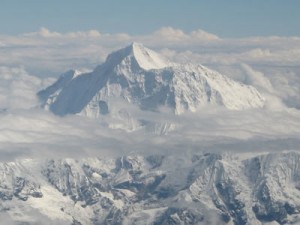
An aerial view of Mount Chomolungma (Everest). (ICT)
The Chinese press has previously reported that the authorities are planning to take the Olympic Torch to Mount Everest, the world’s highest mountain at 29,035 ft, en route to Beijing for the 2008 summer Olympics. But a statement from the China Tibet Mountaineering Association in Lhasa indicates that there will be a trial run of the torch ceremony on the mountain next spring and that the numbers of international expeditions on the mountain will be restricted as a result.
This is possibly because of fears that the torch attempt may go wrong, or because the climbers may witness some form of protest, or actions by the authorities. On September 30, climbers on Mount Cho Oyu witnessed the shooting dead of a 17-year old Tibetan nun by Chinese border patrols, and footage of the incident prompted governments all over the world to raise concern with China (Video footage of Nangpa Pass shooting refutes official Chinese statement, October 13, 2006).
A Chinese spokesman confirmed to journalists two weeks ago that Beijing is “planning to take the Olympic Flame to Mount Everest”, according to a report by AFP featured on the website of China Daily on 18 October. Spokesperson Yang Binyuan said: “It’s a project we’re studying.” In 1999, China took a ceremonial flame to the top of Mount Everest (29,035ft high) during a sports competition. It was connected to an oxygen tank to keep it burning in the thin air and an igniter to re-light the flame when gusting winds blew it out. The Olympic Flame is ignited several months before the opening ceremony of the Olympic Games and carried to the host city by a torch relay.
Experienced mountaineers who have summited Everest told ICT that the move to restrict numbers of climbers at a time when Beijing is preparing for the Olympics was not unexpected and was likely to reflect, among other factors, China’s priorities in ensuring control over the conditions of the Olympic Torch Relay given its symbolic importance. John Ackerly, President of ICT who is also a climber, said: “Climbers come into Tibet with advanced communications devices such as satellite phones and high-speed internet, and the Chinese authorities are likely to be concerned about the ability of these expeditions to record problems and communicate them to the outside world in ways that it cannot control, particularly at such a symbolic moment as the Olympics, when the prestige of the country is at stake.”
In an email communication to a British journalist, reported in The Guardian in the UK (October 28), the China Tibet Mountaineering Association said that it had “negotiated with CMA [the China Mountaineering Association in Beijing] for limiting the number of climbers in Mt Chomolungma (the mountain’s Tibetan name) area in spring 2007”, as part of the preparations for the “2008 Olympic Torch Race”. The extent of the restrictions on international expeditions to Everest next spring was not clear, but the note added that the costs of expeditions would be increased in spring 2007.
On September 30, Western climbers at advance base camp at Mount Cho Oyu filmed a 17-year old Tibetan nun, Kelsang Namtso, being shot dead by Chinese border police while she was crossing the Nangpa Pass into exile with a group of Tibetan monks, nuns, and other adults and children. The footage from Cho Oyu of the shooting and the dead body of the nun was shown across the world, prompting several governments to attempt to hold China to account for its actions. Although this incident is not thought to be linked to the Chinese mountaineering association’s move to limit climber numbers on Everest, it does highlight the potential risks for China’s image internationally of the presence of expeditions in Tibet, particularly in the sensitive border regions. Advance base camp at Mt Cho Oyu, which is 20 kilometers west of Everest, overlooks the Nangpa Pass, a main route into Nepal from Tibet.

